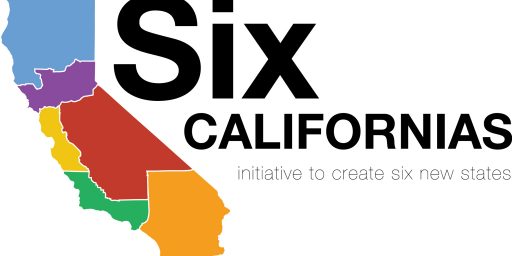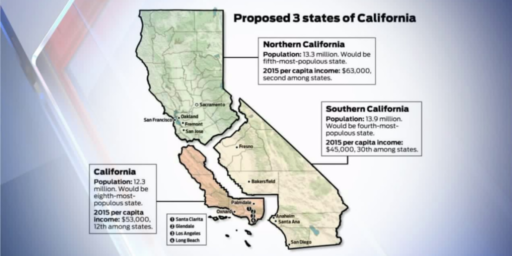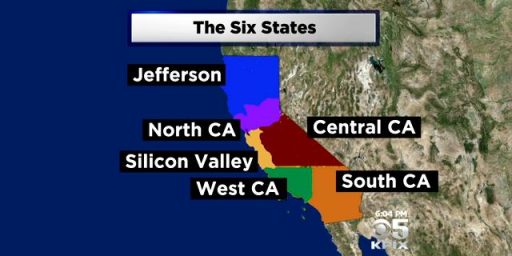California to Vote on Plan to Split into Three States
Tim Draper's fantasy will finally get a vote this November.
California’s 168-year run as a single entity, hugging the continent’s edge for hundreds of miles and sprawling east across mountains and desert, could come to an end next year — as a controversial plan to split the Golden State into three new jurisdictions qualified Tuesday for the Nov. 6 ballot.
There has been talk of splitting our nation’s largest state for years. Yesterday, voters passed an initiative to put it on the general election ballot.
LAT (“Radical plan to split California into three states earns spot on November ballot“):
If a majority of voters who cast ballots agree, a long and contentious process would begin for three separate states to take the place of California, with one primarily centered around Los Angeles and the other two divvying up the counties to the north and south. Completion of the radical plan — far from certain, given its many hurdles at judicial, state and federal levels — would make history.
It would be the first division of an existing U.S. state since the creation of West Virginia in 1863.
“Three states will get us better infrastructure, better education and lower taxes,” Tim Draper, the Silicon Valley venture capitalist who sponsored the ballot measure, said in an email to The Times last summer when he formally submitted the proposal. “States will be more accountable to us and can cooperate and compete for citizens.”
In the initiative’s introductory passage, Draper argues that “vast parts of California are poorly served by a representative government dominated by a large number of elected representatives from a small part of our state, both geographically and economically.”
The proposal aims to invoke Article IV, Section 3 of the U.S. Constitution, the provision guiding how an existing state can be divided into new states. Draper’s plan calls for three new entities — Northern California, California and Southern California — which would roughly divide the population of the existing state into thirds.
Northern California would consist of 40 counties stretching from Oregon south to Santa Cruz County, then east to Merced and Mariposa counties. Southern California would begin with Madera County in the Central Valley and then wind its way along the existing state’s eastern and southern spine, comprising 12 counties and ultimately curving up the Pacific coast to grab San Diego and Orange counties.
A rich history of wanting to slice up California or split it off »
Under the longshot proposal, Los Angeles County would anchor the six counties that retained the name California, a state that would extend northward along the coast to Monterey County. Draper’s campaign website argues the three states would have reasonably similar household incomes and enough industries to produce their own viable economies.It was that issue — economic sustainability — that helped fell two of Draper’s previous efforts in 2012 and 2014 to create six California states. Critics said some of the more rural regions would suffer from extraordinary rates of poverty as individual states, while coastal communities would flourish in new, smaller states where the lion’s share of California tax revenue is generated.
I’m not a California resident and haven’t studied any of the proposals sufficiently to have an opinion as to whether this or one of the other options would be preferable to maintaining a single, giant state. But there’s an argument to be made that three Californias would be more manageable than one. Additionally, since they’d likely continue to work together on most national-level issues, they’d almost certainly increase their clout in the Senate and Electoral College. Indeed, we’d likely see Presidential candidates campaign in the Californias, rather than simply treat it as a piggy bank.
But, of course, the very fact that three Californias would get six Senators rather than two and 59 Electors rather than 55 means that there would likely be opposition from other states, since their own power would be diminished.
As the LAT report notes, we haven’t split a state since West Virginia left in 1863. That was in the midst of a civil war. It’s just about inconceivable that we’ll do it under relatively normal circumstances.





The con is strong with this one.
The referendum is rather meaningless,
In order for anything like this to happen, you’d need the consent of both the California state legislature and Congress, and that’s unlikely to happen. Much like the effort a few years back to split California into six states, this is going nowhere.
It’s an excellent plan. We get two rich blue states and one poor red state. In effect we’d have statewide gentrification. Two gated communities and a third state composed of military retirees and Hispanics. So sorry, Bakersfield, bye-bye! Go ask San Diego to cover your costs for you.
At least my part of the state would have water, unlike the other two. We get Silicon Valley, Napa, Sonoma, Humboldt and SF? So, tech, wine, weed and Rice-a-Roni? Plus 90% of the state’s supply of self-righteousness? SoCal gets the smog, we get the smug? Deal!
Utter silliness.
If things keep shakin’ and erupting out there California may just split up without a vote.
I’m from NorCal and I think this is silly, too. Some in Bakersfield might feel it gives them better representation on the state and national level, since that state would likely be pretty red, as compared to the other two.
But why would this give anyone lower taxes, better schools, better infrastructure? Money doesn’t grow on almond trees.
Stop. Just stop with this nonsense. It’s not going to happen. Never. And we’re really tired of it.
I could be persuaded to vote for an initiative that prohibits any future efforts to break up the state and carries a penalty of serious jail time for anyone who promotes one.
@Kari Q: I mean, unlike the previous initiatives, this one got enough votes to go on the November ballot. And the point of the post was how unlikely this is to get enacted even if Californians somehow vote to pass this in November.
@James Joyner:
I wasn’t grumbling at you, truly. You’re talking about, that’s fine. I don’t have a problem with that. I’m annoyed at Tim Draper and the other people who keep pushing to get these things on the ballot.
But it’s not correct to say this got “enough votes” to make it on the ballot. It takes fewer than 400,000 signatures (in a state with a population of over 39 million) to get an initiative on the ballot, not votes. From experience, the signature gatherers stop people coming out of stores, and try to talk them into signing. People who do stop usually don’t paying attention to what they’re signing, and at $3 per signature, the people collecting signatures have a strong incentive to convince people to sign.
The thing is sates have been broken up before. true, a very long time ago, and most of them were divided while they were colonies of the Crown, but it did happen.
I don’t quite know why the western states are so damn big. I suppose they were so sparsely populated, it made sense to make them huge so as to gather larger populations under one state. If so, things have changed by now in many of them, especially California.
That by itself is no reason to break it up. After all, the change did not happen overnight, and both the people and governments of California have adapted, through many decades, to such gradual change.
BTW splitting a state up would be a change, but hardly a radical one, except perhaps in the number of Senators and electoral votes. Ultimately there’d just be a few more states, something that has happened more recently (see Hawaii and Alaska).